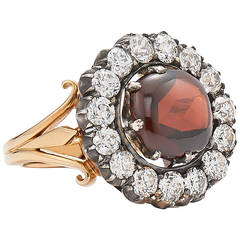Devotion and Friendship are Just A Few Meanings Associated with January’s Birthstone


Kentshire pearl surround Victorian garnet ring.
What better way to usher in a new year than with friendship, devotion, and compassion – just some of the meanings associated with garnets, January’s birthstone?
This gemstone is not only imbued with sentiment but also one of our mantras of last year, which carries over int0 2018-female empowerment. Women born during this month might engage in the belief of the Hindu culture that garnets are associated with the first chakra, or the root chakra, at the base of the spine, meaning healthy sexual activity and feelings of security and stability.
The sometimes fiery red pyrope garnet or more purplish deep majestic red almandine garnet is one that conjures up many legends and has a long historical and storied past. It is also a stone that is available in almost every color – from deep orange to vibrant green – in addition to the red variations. Could you really ask for more from a birthstone? Well if you want more, here are some historical tidbits for you.

Bentley & Skinner’s 19th-century garnet, diamond and enamel pendant
In ancient Egypt, red garnet necklaces were worn by pharaohs and were entombed with their mummified bodies as prized possessions for the afterlife. In Rome, garnets were widely traded gemstones and carved garnet signet rings were used to stamp the wax that sealed the contracts on important documents. In the Middle Ages, from about 475 to 1450 AD, red garnets were favored by nobility and the clergy. And garnets have long been thought of as a traveler’s stone – Noah’s Ark is said to have had a garnet lantern to help navigate during the night.
Speaking of garnets as an historical gem, large deposits of red garnet were discovered in Bohemia in Central Europe around the 16th century, which would became the main focus of jewelry in the 18th and 19th centuries. Bohemian garnet from the Czech Republic continues to be mined today.

Glorious Antique Jewelry’s Georgian foil backed flat cut garnet necklace with foliate motifs
In the Georgian period, garnets were one of the most desirable gemstones – what could easily be referred to as the jewels du jour as they were affordable and complemented almost every complexion. These garnets were flat cut and enhanced by backing them with tinted metal foil in a closed-back setting. The favored styles were parures of foliate and naturalistic motifs with necklaces that split into two bracelets, removable pendants, hair ornaments, and day to night earrings, which offered almost an entire jewelry wardrobe. Motifs such as Maltese Crosses, pansies, witches’ hearts, and portrait and memorial lockets with flat-cut round garnet surrounds were the most popular of the day, first set into silver in the early 1700s and then later into gold.

Fred Leighton’s 19th century garnet with mine-cut diamond surround ring
Although garnets fell out of popularity around 1820, they witnessed a revival in 1880 during Victorian times. Many garnets of the era were rose cut, which were set into low carat gold. There was also a trend towards the traditional handcrafted Bohemian design, which was designed in gilt metal and showed great beauty in a cluster-type arrangement such as the Sun and the Moon, horseshoes, and floral motifs. These tended to show more stone than metal. The brilliant sparkle of Bohemian garnets is due to their transparency and high refraction of light. They were also cut cabochon style or customized to fit the design of various late 19th Century bracelets.

S.J. Phillips’s gold and garnet bracelet, circa 1870
Fast forward to 2018 and you will see everything from the more purplish/pink rhodalite garnets or deeper mysterious almandine as well as all of the myriad colors of this stone. But if you are a red girl at heart—you can choose from modern designer pieces or period styles light up the room, add friendship, devotion and perhaps some more fire to your life.

Mallary Marks’s chain intersecting with garnet link beads

Lily Fitzgerald’s sugarloaf garnet and high karat gold ring
- Cathy Waterman’s garnet and high karat gold wheat leaf earrings
- Silvia Furmanovich’s garnet and opal starburst earrings
- Noor Fares’s garnet drop earrings on gold hoops with diamond accents







